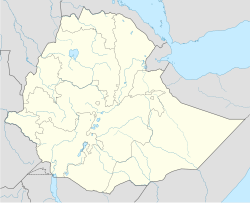Please tell us which country and city you'd like to see the weather in.
| Agula | |
|---|---|
|
|
|
| Coordinates: 13°41′30″N 39°35′30″E / 13.69167°N 39.59167°ECoordinates: 13°41′30″N 39°35′30″E / 13.69167°N 39.59167°E | |
| Country | Ethiopia |
| Region | Tigray |
| Zone | Misraqawi (Eastern) |
| Elevation | 1,930 m (6,330 ft) |
| Population (2005) | |
| • Total | 4,636 |
| Time zone | EAT (UTC+3) |
Agula is a town located in northern Ethiopia. Located in the Debubawi (Southern) Zone of the Tigray Region, it lies about 32 km northeast of Mek'ele, just east of the Mek'ele - Addis Ababa highway, and 25 km north of Qwiha. It has a latitude and longitude of 13°41′30″N 39°35′30″E / 13.69167°N 39.59167°E with an elevation of 1930 metres above sea level. Nearby is a stream and a pass (elevation 2030 metres) which share the same name.
Agula was an important station on the salt caravan route from Dallol west to Atsbi.[1]
History [link]
Agula was visited by the Portuguese priest Francisco Álvares on 13 August 1520, who called it Anguguim. He mentions in the town "a well-built church -- upon very thick stone supports; very well hewn" which was dedicated to Saint Chirqos.[2] The town is mentioned again in an inquiry conducted by Emperor Iyasu I in 1698, in which he proclaimed that tolls should no longer be collected there.[3] The village was visited in 1868 by members of the Napier Expedition, who found the church in ruins; they were told that the church had been reduced to its current state by treasure-seekers acting on the orders of Dejazmach Sabagadis. Based on the "limited information now recoverable", David Phillipson assigns the construction of this church a "Late Aksumite or, perhaps, a subsequent date".[4]
Records at the Nordic Africa Institute website provide details of a primary school in Agula during the year 1968.[1]
Demographics [link]
Based on figures from the Central Statistical Agency of Ethiopia released in 2005, Agula has an estimated total population of 4,636, of whom 2,229 are men and 2,407 are women.[5] The 1994 census reported it had a total population of 2,666 of whom 1,187 were men and 1,479 were women. It is one of three towns in Wukro woreda.
Notes [link]
- ^ a b "Local History in Ethiopia" The Nordic Africa Institute website (accessed 24 July 2009)
- ^ C.F. Beckingham and G.W.B. Huntingford (editors and translators), The Prester John of the Indies (Cambridge: Hakluyt Society, 1961), pp 176-178.
- ^ G.W.B. Huntingford, The historical geography of Ethiopia from the first century AD to 1704, (Oxford University Press: 1989), p. 237
- ^ David W. Phillipson, Ancient Churches of Ethiopia (New Haven: Yale University Press, 2009), pp. 48f
- ^ CSA 2005 National Statistics, Table B.4
| This article about a location in the Tigray Region of Ethiopia is a stub. You can help Wikipedia by expanding it. |


